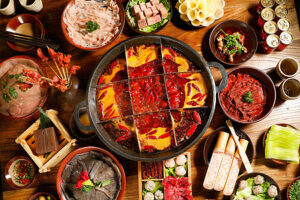Phase 1. Ask: Topic Exploration
- Thinking and Communicating about Hot Pot in Chinese
- Personal and social experiences about Hot Pot in Chinese
Since I used to be a waitress for a Chinese Hot Pot restaurant in Canada two years ago, I could feel the passion and preference for Chinese cuisine from customers. In my experience, people from all over the world would like to try Chinese food with great interests and they wan to learn more about Chinese language and culture. Hot Pot is the most typical and traditional food in China and I realized it could be great to introduce Chinese cultures and languages by eating Hot Pot.
Initial thought and questions:
- What is Hot Pot ?
- What is the impression of Hot Pot in Chinese history ?
- How to say Hot Pot and other relevant ingredients in Chinese ?
- What are the table manners when we are eating Hot Pot? It there anything we need to notice?
- How to use basic Chinese to communicate with restaurant service?
For the aliveness of this topic, learning a language is to learn a different culture background. Abundant cultures input could help students build up the diverse worldview. Chinese is one of the most ancient languages in east countries. To learn some Chinese, students could switch their logic thinking for speaking English and learn a new thinking way to speak Chinese. The best for students to learn a language is to expose them to the language context and environment. Kim (2020) acknowledges that when we teach language, we should be helping people participate in ways of life. This goes beyond knowledge of subject matter, and it goes beyond any simple type of well-being. For me, in order to learn English, I went to Canada for study. For Canadian students who want to learn Chinese, since Canada is an immigration country, they could find the Chinese language context easier. Hot Pot restaurant could be a good choice for them to go.
For the history of this topic, culture shock and acculturation could be the hot issues for the languages learning students. This project aims to the Grade 12 Canadian students who are interested in Chinese languages and have the possibility to go to the universities located in China. The experiences of eating in traditional Chinese restaurant could be the treasure for them to study and learn Chinese.
For the controversies of this topic, Hot Pot is a very spicy. Some students might be really sensitive to the smell of spicy food since they have allergies to specific food or rhinitis so this project might not be suitable for them to participate.

(https://www.google.com/search)
For the deeper understandings of this topic, I suppose that language learning is not supposed to be limited into the in-class teaching. In “Introduction to BC Redesigned Curriculum”, it brings up a conception about flexible learning environment, which means learning can take place in any where, not just in classroom. Using the language is the ultimate aim for us to learn another language. The language background such as Chinese restaurant could provide the opportunities for students to apply Chinese into the daily life. The best way to remember the complex vocabulary, sentence structures expressions and food names is to taste them and feel them. So when students enjoy the Hot Pot, it must be the very time for learning Chinese and Chinese cultures, which is an efficient way to learn languages. For me, I did not know what is beef steak in my childhood. My mother bring me to the western restaurant to eat so I learned some words for western-style food and table manners.
I hope to teach this topic through inquiry-based pedagogy since in “Focus in Inquiry”, it is mentioned that making observations, asking questions and pursuing investigations – it’s how humans have come to understand the world. I think is it the same way for learning Chinese from start of knowing its culture, cuisine and convention. In this enjoyable and exploring learning procedure, students could learn the Chinese naturally and effectively.
Other key questions:
- Why Hot Pot is the most representative food in China?
- Why do we have to use chopsticks when we are eating Hot Pot?
- What is the differences between Chinese pepper and other pepper such as Indian pepper/ Mexican pepper through students’ own experiences?
For the BC Curriculum for Grade 12 students learning Chinese, it regulates that students recognize the regional and ethnic diversity of language and culture in China and in Chinese communities throughout the world. Hot Pot restaurant could engage students in the language learning contest and make them experience the cultural diversities through the delicious and traditional Chinese cuisine. In this procedure, students could identify and explore opportunities to continue language acquisition beyond graduation.